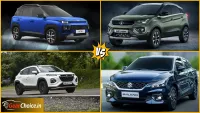If you drive a car every day—to work, to highway trips or to the hustle and bustle of the city—the right car accessories can make your drive safer, more comfortable and smarter. Below is a practical, human-written guide covering everything from the essentials to the premium—what to buy, how to choose and how to maintain it.
1) Must-Have Accessories
Dashcam: Provides solid evidence in case of any confusion or accident on the road.
Tire Inflator + Digital Pressure Gauge: Instant help in case of low air pressure, improves both mileage and tyre life.
Puncture Repair Kit: A quick solution to small nail/screw punctures.
First-Aid Kit: Basic medicines, bandages, antiseptic—always carry it with you.
Reflective Warning Triangle/Jacket: Improves visibility when the vehicle is stopped at night.
Jump starter/jump cables: A lifesaver if the battery is down.
Wiper blades (good quality): Clear visibility in rain/fog is straight up safety.
Why? These things are the basic pillars of “emergency + safety”—start with them.
2) Comfort & Convenience
Phone mount (stable): Safe and anti-wobble for navigation.
Fast USB-C/PD charger + quality cable: No battery stress on long drives.
Sunshades/windshield shades: Reduce dashboard heat and glare.
Seat cushions/lumbar support: Reduces back pain on long distances.
Trash bin/clean-up kit: If the car is clean, the mood is good, resale value is better.
Organizer (seat back/boot): Bottles, tissues, umbrella—all organized.
3) Tech and Smart Upgrades
TPMS (Tyre Pressure Monitoring System): Tire pressure/temp will be visible live, reducing blow-out risk.
Reverse Camera/Parking Sensors: Confidence in tight parking.
OBD-II Scanner (Basic): Will be able to read errors like check-engine; helpful in DIY diagnostics.
Blind-Spot Mirror: Increases safety in side switching.
Note: Read warranty terms before any electrical fitment and get the work done by a trusted technician.
4) Maintenance and Detailing
Microfibre Cloth (Several GSM): Less scratches on paint, better cleaning.
All-purpose Cleaner/Interior Detailer: For removing stains/dust.
Tire/Dash Dressing (Non-Greasy): Clean, matte finish looks good.
Quick Wash/Waterless Shampoo: Best if space/water is limited.
Air freshener/carbon deodorizer: Absorbs odor, keep fragrance mild.
5) According to weather/road conditions
Rubber/TPV floor mats: Better than fabric in water/mud.
Boot liner (waterproof): Luggage/vegetables/items will not spread dirt.
Rain-repellent/glass treatment: Raindrops will slide off, visibility will increase.
Snow/cold weather kit (for hilly areas): Anti-fog, de-icer, blanket etc.
6) Style and protection (with balance)
Seat covers (fabric/PU/leatherite): Stock seats will be saved, look will be upgraded.
Door edge/bumper protector strips: Reduce parking scuffs.
Anti-slip dash mat/tray: Things will not slip.
Ambient lighting (subtle): Soft look during night drive—not distracting, keep brightness low.
Tip: Focus only on “functional + neat” modifications. Flabby/sharp things get boring fast and don’t add resale value.
7) How to choose? (Buying Checklist)
Decide your need: Safety/Comfort/Maintenance—which category is missing?
Compatibility: Check your car model/trim (size, power rating, mounting).
Quality/Brand reliability: Warranty, reviews, spares/support availability.
Installation: DIY or professional? Check wiring/fuse safety.
Maintenance: Cleaning/spare parts/consumables availability.
Regulations: Avoid anything that is against local regulations (e.g. glaring lights, loud horns, etc.).
8) Fitting and maintenance (Pro Tips)
Electrical fitment requires in-line fuses and correct gauge wires.
Avoid exposed wiring/tape-joints; use heat-shrink/connectors.
Degree the surface before applying adhesive (3M tape), allow 24 hours to dry.
Keep the angle and calibration of dashcam/sensor correct.
Clean-up/re-tightening every 3–6 months—especially in high-vibration areas.
9) Common mistakes to avoid
Buying no-name electrical thinking “it’s cheap, so be it.”
Gadget overloading: too many chargers/lights/devices at once.
Fittings blocking visibility on windshield/A-pillar.
Strong smells/too much ambient light—distraction while driving.
Missing the warranty/return policy without reading it.
10) Recommended List for New Car (Starter Pack)
Dashcam, Tyre Inflator, Puncture Kit, First-Aid, Warning Triangle
Phone Mount, Fast Charger, Rubber Mats, Boot Liner
Microfibre Cloth + Quick Detailer, Wiper Blade Upgrade




